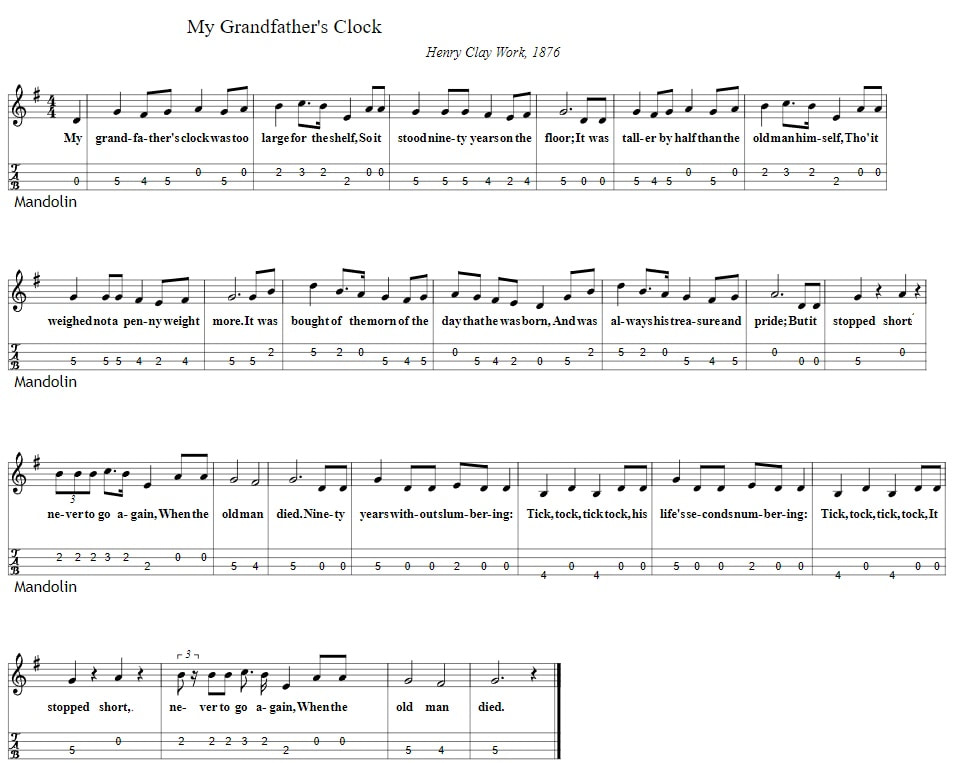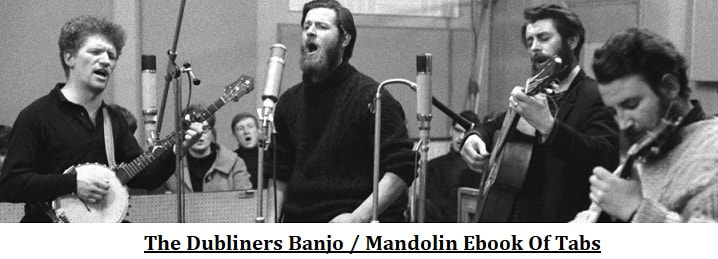Grandfathers Clock Mandolin Sheet Music Tab
My Grandfathers Clock Mandolin Sheet Music Tab In G Major.
The Grandfather's Clock song, also known as 'My Grandfather's Clock,' is a beloved and iconic piece of American folk music. Its catchy tune and nostalgic lyrics have made it a popular choice for sing-alongs and performances for generations. However, beyond its surface-level appeal, this song holds a deeper significance in the cultural and historical landscape of America.
The origins of the Grandfather's Clock song can be traced back to the mid-19th century. The melody was composed by Henry Clay Work, a prolific songwriter who is best known for his contributions to the genre of American Civil War music. It is said that Work was inspired to write the song after seeing an old clock in the George Hotel in Piercebridge, England. However, the lyrics of the song were not written by Work, but instead by a British songwriter, George William Elliott.
The song tells the tale of a grandfather's clock that has been in the family for generations. The clock continues to tick and chime throughout the years, a symbol of the passing of time and the memories it holds. The lyrics evoke a sense of nostalgia, as the clock is described as 'tall and grand' and 'stood ninety years on the floor.' The clock is personified, almost as a member of the family, with its 'voice like a cheerful and pleasant chime' and its 'hands never hung idle by his side.'
On the surface, the Grandfather's Clock song may seem like a simple and charming ditty. However, it holds a much deeper meaning when placed in the context of American history. The lyrics reflect the importance of family and tradition, values that were highly cherished in the 19th century. The clock, with its constant ticking and chimes, symbolizes the passing of time and the idea that nothing is permanent. This sentiment would have been particularly resonant during the tumultuous period of the Civil War, when many families were torn apart and lives were forever changed.
Moreover, the Grandfather's Clock song also holds a significant place in the development of American music. At the time of its creation, America was still a relatively young nation, and its musical identity was still in the process of being shaped. The song's simple yet catchy melody, along with its relatable and sentimental lyrics, made it a popular choice for community sing-alongs and parlor performances. This helped to solidify its status as a quintessential piece of American folk music.
Over the years, the Grandfather's Clock song has been covered by numerous artists, further cementing its place in popular culture. In 1876, it was featured in the Centennial Exposition in Philadelphia, where it was played on a clock with a 12-foot face. In 1928, it made an appearance in the first 'talking picture' The Jazz Singer, sung by Al Jolson. It has also been covered by artists such as Johnny Cash, Johnny Cash, and The Statler Brothers.
In conclusion, the Grandfather's Clock song is more than just a simple tune about a clock. It holds a significant place in American music history and serves as a reminder of the values and sentiments of a bygone era. Its universal themes of family, tradition, and the passage of time continue to resonate with audiences today, making it a timeless and beloved piece of American cultural heritage.
The origins of the Grandfather's Clock song can be traced back to the mid-19th century. The melody was composed by Henry Clay Work, a prolific songwriter who is best known for his contributions to the genre of American Civil War music. It is said that Work was inspired to write the song after seeing an old clock in the George Hotel in Piercebridge, England. However, the lyrics of the song were not written by Work, but instead by a British songwriter, George William Elliott.
The song tells the tale of a grandfather's clock that has been in the family for generations. The clock continues to tick and chime throughout the years, a symbol of the passing of time and the memories it holds. The lyrics evoke a sense of nostalgia, as the clock is described as 'tall and grand' and 'stood ninety years on the floor.' The clock is personified, almost as a member of the family, with its 'voice like a cheerful and pleasant chime' and its 'hands never hung idle by his side.'
On the surface, the Grandfather's Clock song may seem like a simple and charming ditty. However, it holds a much deeper meaning when placed in the context of American history. The lyrics reflect the importance of family and tradition, values that were highly cherished in the 19th century. The clock, with its constant ticking and chimes, symbolizes the passing of time and the idea that nothing is permanent. This sentiment would have been particularly resonant during the tumultuous period of the Civil War, when many families were torn apart and lives were forever changed.
Moreover, the Grandfather's Clock song also holds a significant place in the development of American music. At the time of its creation, America was still a relatively young nation, and its musical identity was still in the process of being shaped. The song's simple yet catchy melody, along with its relatable and sentimental lyrics, made it a popular choice for community sing-alongs and parlor performances. This helped to solidify its status as a quintessential piece of American folk music.
Over the years, the Grandfather's Clock song has been covered by numerous artists, further cementing its place in popular culture. In 1876, it was featured in the Centennial Exposition in Philadelphia, where it was played on a clock with a 12-foot face. In 1928, it made an appearance in the first 'talking picture' The Jazz Singer, sung by Al Jolson. It has also been covered by artists such as Johnny Cash, Johnny Cash, and The Statler Brothers.
In conclusion, the Grandfather's Clock song is more than just a simple tune about a clock. It holds a significant place in American music history and serves as a reminder of the values and sentiments of a bygone era. Its universal themes of family, tradition, and the passage of time continue to resonate with audiences today, making it a timeless and beloved piece of American cultural heritage.



